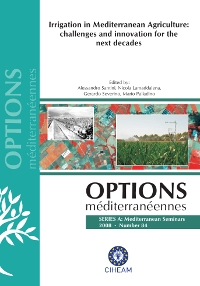| Article précédent | p. 223-233 | Article suivant |
Land surface temperature from remote sensing and from an energy water balance model for irrigation management
Soil Moisture is recognized as the key variable in the hydrologic water balance for operational purpose as for flash flood forecast system as well as for irrigation management. Respect to this role it is most of the time confined to an internal numerical model variable often without any control with measured data. This is mainly due to its intrinsic space and time variability and to the well known difficulties in assessing its value from remote sensing as from in situ measurements. The present paper investigates the possibility to control surface soil moisture trough the detection of land surface temperature from satellite remote sensing due to the simpler information and availability of infrared satellite images respect to the microwave ones. In this context the paper tries to asses soil moisture values and its spatial and temporal dynamic developing an energy water balance model (FEST-EWB) tested at field scale with fluxes measured from an eddy tower. Modelled soil moisture and temperature values are also compared with operative satellite data (MODIS) and in situ ground measurements.
L'humidité du sol est reconnue comme étant la variable clé du bilan hydrologique à fins opérationnelles, comme la prévision des inondations et la gestion de l'irrigation. Elle est donc souvent présentée dans les modèles comme une variable numérique interne sans aucun contrôle avec les données mesurées. Cela est principalement dû à sa variabilité intrinsèque dans l'espace et le temps, et aux difficultés d'évaluer sa valeur à l'aide de la télédétection et des mesures in situ. Cet article étudie la possibilité de contrôler l'humidité du sol à partir de la détection de la température de surface (LST) par télédétection satellitaire, vue la simplicité de l'information et la disponibilité des images satellitaires infrarouges ainsi que celles à micro-ondes. Dans ce contexte, l'article essaie d'évaluer l'humidité du sol et son dynamisme spatio-temporel en développant un modèle de bilan hydrique et énergétique (FEST-EWB) examiné à l'échelle du champ en mesurant les flux à partir d'un circuit de courant. Les valeurs simulées de l'humidité et de la température du sol sont également comparées aux données d'un satellite (MODIS) et aux mesures effectuées in situ.
- [ Afficher ]
- [ Télécharger ]
- [ Exporter la citation ]
Vous pouvez télécharger la citation au format :
- [ Imprimer ]
-
Mots-clés
BILAN ENERGETIQUE, BILAN HYDRIQUE DU SOL, IRRIGATION, MODELE, TELEDETECTION, TEMPERATURE DU SOL, TENEUR EN EAU DU SOLCiter cet article
Corbari C., Horeschi D., Ravazzani G., Mancini M. Land surface temperature from remote sensing and from an energy water balance model for irrigation management. In : Santini A. (ed.), Lamaddalena N. (ed.), Severino G. (ed.), Palladino M. (ed.). Irrigation in Mediterranean agriculture: challenges and innovation for the next decades. Bari : CIHEAM, 2008. p. 223-233. (Options Méditerranéennes : Série A. Séminaires Méditerranéens; n. 84). International Conference on Irrigation in Mediterranean Agriculture: Challenges and Innovation for the Next Decades, 2008/06/17-18, Naples (Italy). http://om.ciheam.org/om/pdf/a84/00800969.pdf



